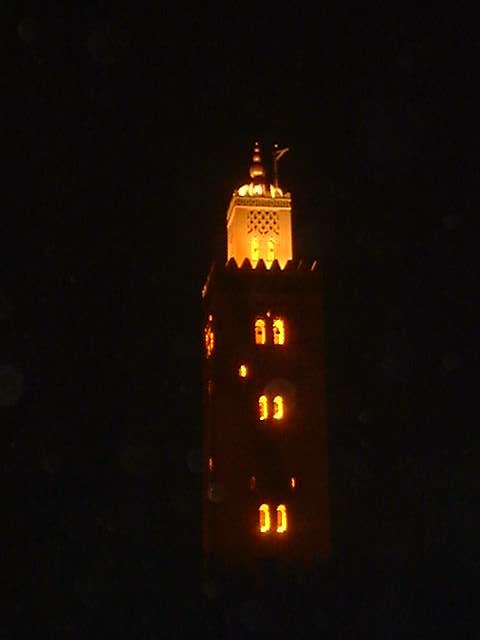 |
Koutoubia Mosque at night
Marrakesh, Morocco (20Nov00) |
Located at the far extremity of Europe, Southern Spain sits at one of
the most facinating geographic and cultural boundaries in the world: only
13km at its narrowest point, the Straight of Gibraltar draws a fine yet
dramatic line between not only Europe and Africa, but also between
Catholicism and Islam, rich and poor, "developed" and "developing."
The Straight of Gibraltar is also the mouth of the Mediterranean, making it
one of the most strategic waterways in the world. As a result, the region
has a long history of power struggles, and even today, it is the source of
much international tension.
My first attraction to the area, however, involved an entirely different
kind of power struggle: man against wind. The mouth of the Mediterranean
is not only an important shipping channel, it serves as a giant tunnel for
the tremendous winds which blow in and out of the Mediterranean Sea.
Tarifa, a tiny town just outside the mouth, is one of the windiest
shorelines in the world, and has become the windsurfing capital of Europe. Seeing as I've invested thousands of dollars and hundreds of hours flailing
around in the San Francisco Bay learning to windsurf, I was morally
obligated to make a stopover to check it out.
Europeans only seem to take vacation in the summer, so in the middle of
November, I pretty much had the place to myself. Luckily, the wind doesn't
get vacation, so conditions were great. The only problem was finding
someone to rent me gear. The town was almost a ghost town, with sign after
sign saying "Closed for the holidays." It seemed that November was the
time that all the local businesses took vacation to recover from the busy
tourist season. Even the shuttles that ran to and from the beach had
stopped for the season, so I was forced to walk five kilometers to get
there. I tried
hitchhiking, but it soon became clear that I didn't have the patience for
it, and I gave up after ten minutes. I preferred walking for an hour and a
half to standing around waiting, staring pitifully at oncoming cars,
hoping to evoke enough sympathy to catch a ride.
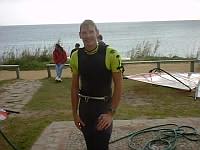 |
Just back from windsurfing
Tarifa, Spain (11Nov00) |
When I got to the beach, the wind was howling and dozens of brightly colored
sails were darting back and forth on the horizon. The beach itself,
however, was deserted, the small shacks that were doubtless teeming with
activity in the summer boarded shut. Only the locals were out. I walked
along the shoreline, the wind sand blasting me the entire way, until I
found another grouping of sails on the horizon, this time with a staffed
and equipped shop nearby. It was a German outfit, catering specifically to
German package tourists, and they were all booked up. As the afternoon
wore on, however, the force seven winds took their toll on the other
sailors, and one by one they retired, worn, blistered, and smiling. Enough
equipment eventually freed up that I was allowed to go out, and I took my
turn getting worked over by the strong "poniente" winds. It felt great to
be out on the water.
The next day, the wind decided to take the day off, so I just sat on the
beach, trying to catch up on the craziness unfolding in the US presidential
election from the Spanish newspapers. Little did I know that it would take
another month for it all to conclude.
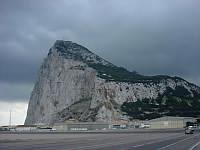 |
The Rock
Gibraltar, England (13Nov00) |
My windsurfing fix sated for the time being, I said goodbye to Tarifa and
continued my journey along the coast to Gibraltar. A small spit of land
five kilometers long and one kilometer wide and dominated by the giant and
iconic Rock of Gibraltar, Gibraltar is a strange anomoly resulting from its
unique and strategic location. For centuries, control of Gibraltar bounced
back and forth between the Moors and the Spanish, until, in 1713, the
British gained control by intervening on behalf of the French in The War of
Spanish Succession. Ever since, Spain has been trying to win it back,
mounting attacks on fifteen separte occasions. The border between the two
was closed until 1985, and even today, Gibraltar is a source of tension in
British-Spanish relations. Although it is a symbolic last vestige of the
once great British Empire, it is not clear that it serves much
strategic importance any more for Britain. As in the case in other British
territories, however, the locals want to retain their sovereignty. Spain's
claim to sovereignty seems rather hypocritical, seeing as they still occupy
tiny specks of land, Ceuta and Melilla, located on the other side of the
straight in Morocco.
During my visit, tensions were especially high, since a British nuclear sub
had recently broken down in the Mediterranean and was receiving emergency
repairs at the facilities in Gibraltar, and Spain was none too happy about
having a crippled nuclear sub in their backyard.
Crossing into Gibraltar is one of the strangest border experiences I've
had. Spain doesn't even acknowledge the existence of Gibraltar, and all
transportation stops at the nearby town of La Linea: "The Line." From
there you have to walk along a narrow sand spit until you reach customs.
After showing your passport, you then walk across Gibraltar's runway to get
to the town. The runway was bult by the British during WWII, and since no
flat land was available, it was built on landfill perpendicular to the
small isthmus connecting Gibraltar to Spain. Traffic lights tell you when
it is safe to cross.
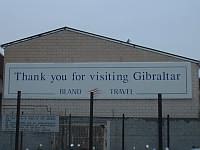 |
A little too honest?
Gibraltar, England (13Nov00) |
The term "Safe as The Rock" came about for a good reason: Gibraltar is
heavily fortified. All along the cliff face are small caves that were used
to guard against any invaders, and the original entrance required going
through a tunnel to get to the town. Today, roadways circumvent the
tunnel.
Walking along the main street of town, which is really the only street, is
indistinguishable from Main St. of any small British town: boxes for Royal
Mail, Marks and Spencers, pubs with John Courage on tap serving pasties and
chips. While intimately tied to Britain, Gibraltar is amazingly
self-sufficient. It has its own government, its own ferry service, even
its own currency. Called the Gibraltar Pound and financially equivalent to
Pounds Sterling, the bills have a picture of the one and only view of the
town on them.
The novelty of a tiny pocket of Britain hidden away on a rocky peninsula
soon loses its charm, so after a mushroom pie and a couple of pints, I
headed back to Spain. I went to Algiceras, a pit of a town with few other
redeeming qualities other than its role as the gateway to Morocco. Several
ferries a day made the two and a half hour journey across the straight to
Morocco. I hadn't really given much thought to going to Morocco - a side
trip to an entirely different continent seemed so counter to my desire to
be on a "European" travel leg, but once in Algeciras, the draw of an
adventurous, Third World travel experience was just too much for me to
resist. I decided that I needed to see if Morocco was really as horrible,
wonderful, dirty, frustrating, and magical as people had made it out to be.
The moment I stepped off the ferry into Tangier it was clear that I was no
longer in Europe. Swarms of taxicab drivers descended, and soon we were in
full negotiations for the cab fare. I had met a couple of other Americans
on the ferry, and all of us were trying to bypass Tangier altogether and
get straight to Marrakesh. Luckily for us, there was a night train leaving
in a couple of hours, so we went straight to the train station. I really
like night trains; there's something about going to sleep and waking up in
an entirely different place. The sleeping car reminded me exactly of the
ones in India - a tiny room with two rows of three stacked beds. The top
bunk was so close to the ceiling that you could barely roll over without
hitting your shoulder. You get to know your fellow passengers pretty
quickly in such close quarters. In addition to the two Americans I had met
earlier, there was also a British woman who had moved to Morocco to work
for a travel company there.
The train took twelve hours, including a three hour layover in Casablanca.
By the time we arrived in Marrakesh, we were all looking a little worse for
wear.
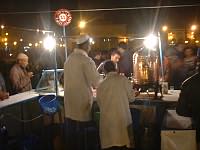 |
Djemaa el-Fna plaza
Marrakesh, Morocco (15Nov00) |
We headed for Place Djemaa el-Fna, the central plaza, to begin looking for
accomodation. Marrakesh, like all the imperial cities in Morocco,
consisted of the old city, or medina, which dated back to 1062, and the
ville nouvelle, or new city, built by the French in the eary 20th century.
Just off the plaza was where all the budget accomomdations are, so I broke
off from the others and started my hunt for a room. Since the medina was
built when pedestrians and donkeys were about the only traffic going, the
walkways were narrow and labyrinthine, and I would only be able to make a
few turns before having to retrace my steps to avoid getting lost. It was
nearly impossible to walk alone, as locals would come up to me and try to
lead me to their favorite hotel where they would get a commission. I hate
being led to places I don't want to go, so I would try to lose them, but as
soon as I shook one off, another would glom onto me.
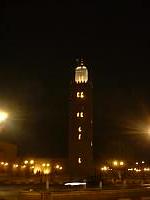 |
Koutoubia Mosque
Marrakesh, Morocco (14Nov00) |
All of the hotels looked alike; each had a central courtyard, often filled
with orange trees, with rooms facing the courtyard. Everything
was covered in elaborate tiles, from the walls to the floors. Even the
most grungy, low budget places had a sense of wonder and royalty to them.
The going rate was about 50 Dirham/night (~US$5) but it was clear that
Morocco was a kind of place where everything required a hard bargain, so I
was determined to pay no more than 40. Very few places had single rooms,
but I eventually found one place I really liked named Challah. In my
attempt to bargain down the price, they eventually offered me a small room
opening right into the courtyard. It didn't have a door per se, simply a
tiny window-like opening which was a foot or so off the ground and only a
few feet high, but I loved it, and immediately settled in.
I was supposed to meet up with Katherine, the British woman from the train,
for drinks, but I was starting to feel rather sick, so at noon I went
straight to bed and slept until 8pm. When I woke up, it was clear that I
was only getting sicker, but I decided to venture out for a couple of hours
and explore.
Walking into Place Djemaa el-Fna was a moment I will never forget. It had
completely transformed; row after row of food stalls had been installed,
and thousands of people were seated on large benches eating. In the open
spaces, entertainers of all sorts drew huge crowds, from fire eaters to
medicine men to musicians. Glowing white steam lit up the entire plaza, as
small gas lanterns lit up the steam from the food stalls. Every few
seconds giant bursts of flame would erupt from one of the fire eaters'
mouths off in the distance. It was a giant circus and food court all
rolled into one. It was as surreal as any scene I'd seen, and reminded me
of Burning Man, the giant desert festival I'd been to over the summer. It
was sensory overload.
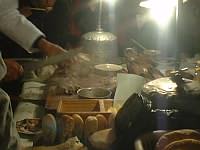 |
Dinner in the plaza
Marrakesh, Morocco (16Nov00) |
After overcoming my awe, I started to weave my way through the various
entertainers. Each one would be surrounded by a huge ring of people, everyone
trying to get close to the action. There were belly dancers mysteriously
shrouded in veils, jugglers, fire eaters, and some people who I just
couldn't figure out. They would pace back and forth, stopping suddenly to
scream something to the crowd. It was as if, in that very moment, they had
been possessed by a demonic force. Then then would pace again, and start
scribbling on the ground with chalk. The crowd was rapt, seemingly hanging
on each word like it was gospel. The more mysterious the performance, the
bigger the crowd.
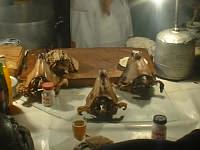 |
Goat's head soup
Marrakesh, Morocco (16Nov00) |
I made my way over to the food stalls, which were equally magical and
mesmorizing. I walked from one booth to the next, trying to determine what
brews wre bubbling away in the giant vats. Each stall was packed with
people and manned with someone wearing a white coat and matching cap.
There were surprisingly few tourists in the plaza, but the ones that were
there had all congregated at the same food stalls, shipwrecked
refugees clinging together in a sea of chaos and confusion. It seemed that
those stalls were the ones with the multi-lingual hawkers, who would spew
greetings in French, English, and German until they got a response.
I kept as far away as possible, opting instead to sit at the stalls with
masses of Moroccans seated around giant vats, each with a small bowl and a
round of flat bread. The offering was lentils, and for only five dirham
(US$.50) you got all you could eat. People would keep asking for either
more bread or more lentils, and everyone seemed to keep eating until the
timing was such that they ran out of bread and lentils at the exact same
time. It usually took about three bowls.
Once done with lentils, I moved on to find my next choosing amongst booths
selling skewers of unknown meat, hearts, kidneys, tripe, brains, and snails.
I eventually opted for snails. They too were served from a giant vat, and
the servers would continuously stir the shells, making a sound like pebbles
washing up on the beach. Ten Dirham for a giant bowl. It was my first
escargot experience, and I really liked it. My final course was at the
stall serving goat head. I just had to try. They would take entire heads
(minus the brains) and boil them. Then, they would cleave the head in half
with a giant cleaver, and pick out all the bone fragments. What was left
was chopped up and served with cumin. I know you probably won't believe me
on this one, but it really wasn't bad.
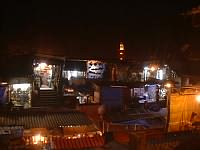 |
The souqs (markets)
Marrakesh, Morocco (15Nov00) |
With each meal came the requisite mint tea, the making of which the
Moroccans have elevated to a fine art. In order to get just the right
combination of mint and sugar, they kept pouring the tea and returning it
to the pot. In order to get the right mixing action they would pour it
from a great height, never spilling even a drop. The smell of mint tea
will forever remind me of Morocco.
For dessert, I gravitated to the few stalls at the entrance to the plaza,
each of which had a giant copper kettle brewing over a gas burner. Served
from the kettle was a seemingly endless supply of a thick, reddish-brown
fluid. Also on the table were domes of a strange brown paste as well as
tiny paste balls. Not knowing quite how it all worked, I just held up one
finger, indictating I wanted one of the usual. I got a glass of the
liquid, as expected, but I also got one of each of the brown paste
offerings - two different balls and shavings off each of the domes. The
paste was a spice paste, with a dense flavor of cumin coriander, cinnamon,
sugar, and other exotic flavors. I couldn't really tell the difference
between the various types, but they were all good. The drink tasted like a
liquid form of the paste. It seemed almost medicinal, and it felt like it
was doing me some good.
My senses raw from exposure, and my stomach stuffed, I headed back to sleep.
The next day was spent entirely in my tiny room. It was pouring rain
outside, and it was clear that I had developed some sort of flu, so I just
slept all day, emerging only for another quick visit to the night circus in
the plaza. Once I left my room, the staff of the hotel quickly darted in
and returned with a huge pile of sheets and blankets. It turns out that my
"room" was actually the linen storage room, and they had been patiently
waiting all day for me to emerge so that they could get linens to make up
the rooms.
By the next day, I was back in full health and ready to do the full tour of
the medina. I returned to the main plaza, and all traces of the previous
night's activity were gone. The food stalls were gone, and the night's
entertainment had been replaced by snake charmers, henna tattoo artists,
and quacks. Even the cure-all sellers worked snakes into the act. One in
particular was trying to sell small silver packets, which puportedly had a
sort of protective power. To demonstrate, he would pull a cobra out of a
bag, and then taunt it, forcing it to attack. Another provocation, this
time with a few silver packets in his hand, and the snake didn't budge.
His wife would then get into the act, holding a handful of silver packets
as she drank hot water directly from the spout of a boiling kettle. I can
only imagine waht doing that act day after day has done to the inside of
her mouth.
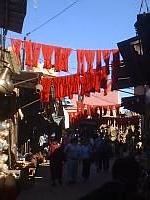 |
The medina (old city)
Marrakesh, Morocco (17Nov00) |
The medina is essentially a functioning medieval city, and day to day life
probably hasn't changed much in centuries. The plaza may have been the
heart of the medina, but its liveblood was the countless markets, or souqs
which clogged the narrow streets leading from the plaza. You could find
just about anything there, from dates to meats to vegetables and spices.
From hookas to brass lamps to pottery to clothes to countless bright yellow
slippers. It was a visual splendor; boys carefully dusting their wares,
old men in beards smiling and inviting me in, shiny lamps hanging against
crumbling clay walls, people wearing beautiful robes in amazing colors,
from earthly red, saffron, olive, and creme to outrageously bright purple,
royal blue, and lime green. Most women wore veils to complete the covering
of their entire bodies.
Things were loosely ordered into districts, with several streets dedicated
to selling just dates, figs, and nuts, for example. There were so many
shops that it wasn't clear how they would ever be able to find enough
customers to support them all, which was exactly the problem as a tourist.
Every shopkeeper would hassle me as if I were the only customer they'd seen
all week - and perhaps I was. The intense sales pressure made it extremely
difficult to just browse.
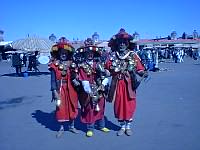 |
Water sellers
Marrakesh, Morocco (15Nov00) |
The medina is more than just markets; not only are goods sold there, they
are made there as well. In every nook and cranny, someone would be sewing,
painting, carving, or hammering away. The sounds from the metalworking
district could be heard from "blocks" away. It was clear once I had found
it from the piles of twisted metal lining the streets and the sparks of
welders flying everywhere. In every doorway, there would usually be
several men or boys pounding away, adding intricate patterns to lamps,
bowls, or picture frames. Men wore scarves and sunglasses to "protect"
themselves while welding. Not exactly OSHA standards.
Navigation was very difficult, as all of the narrow streets looked
identical. Most tourists visited the medina in large guided packs like
they were visiting some strange interactive museum. The whole experience
reminded me of those giant mazes in amuzement parks when I was a kid. I'd
go in one door, run around for a few hours completely disoriented and
eventually pop out one of the many side exits. I'd then get my bearings
and head back for the main entrance to try again.
After several hours, I eventually learned my way around. The goatskin and
henna lamp district was near the metalworking district, and from there you
could cut back through the garment district out to the main street.
After a few days of the hustle and bustle of the souqs, I was
ready to escape. So I said goodbye to the city, squeezed into
an old Mercedes diesel sedan "gran taxi", and headed for the mountains.

